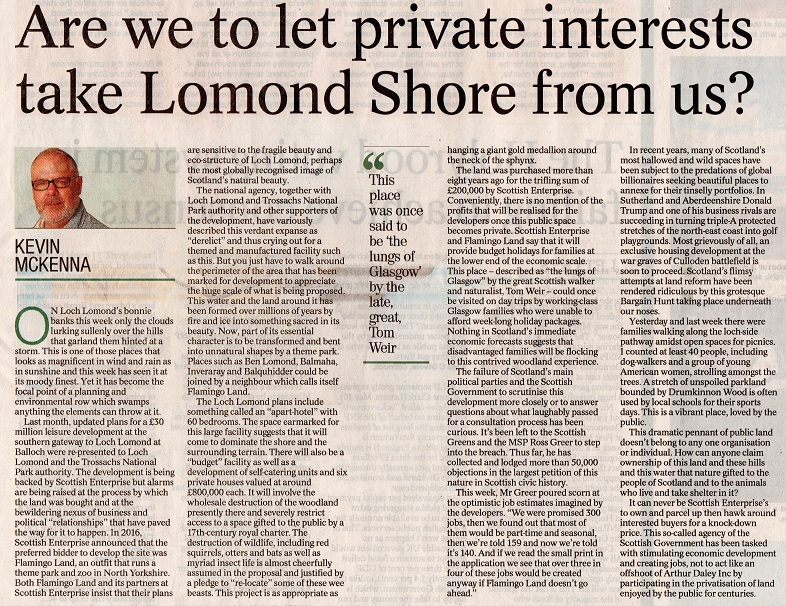
[This post was corrected and updated in June 2024 after I identified a mistake about the price Scottish Enterprise had paid for the Riverside Site].
Last week I mentioned the growing media interest in the Flamingo Land proposals at Balloch and it was great to see this powerful piece from Kevin McKenna at the weekend. Mr McKenna got one thing wrong, however – or perhaps a mistake was made in the editing? Scottish Enterprise did not acquire the Riverside Site at Balloch for the “trifling sum” of £200,000 over eight years ago. £200k is the amount that Scottish Enterprise apparently told Jackie Baillie, the local labour MSP, the site was worth.
Ignore for the moment the financial contributions Scottish Enterprise have made towards the cost of their joint planning application with Flamingo Land (see here), Parkswatch has recently been passed information about the original cost of acquiring the land on the Riverside Site for the public:

Information now available from the Registers of Scotland website clarifies that the £180k was for the Riverside part of the site, comprising the old station and former railway yards along the River Leven, while the £2,380,000 was for the land to the west, around and south of Drumkinnon Bay, some of which is now occupied by the Lomond Shores development
This makes the worst of Thatcher’s public asset fire sales appear good value. Property prices have inflated more than almost any other area of the economy so its not unreasonable to assume that these original investments should now be worth many times more than what was paid. Were the Flamingo Land Planning Application to be approved, the Riverside Site would become a piece of prime real estate, even if the real truth is the gateway to Loch Lomond is worth far more than money can buy. Yet Scottish Enterprise is now apparently going to sell this public asset for a measly £200k. If that is not corrupt, I am not sure what is. If Scottish Enterprise is prepared to sell the site for this amount, then there is no reason it should not transfer it to the local community.
Time for the Scottish Government to intervene..
Scottish Enterprise will no doubt claim that they are legally bound by the Exclusivity Agreement they signed with Flamingo Land. This, they claim, prevents them disposing or transferring the land to anyone else. Interestingly, the Exclusivity Agreement was only signed AFTER the Balloch Charrette was over even though Scottish Enterprise had agreed to appoint Flamingo Land before the charrette started. Throughout the whole charrette process both Scottish Enterprise and the Loch Lomond and Trossachs National Park Authority kept Flamingo Land’s appointment secret from the public. A deeply cynical and manipulative act.
The Exclusivity Agreement no doubt contains an agreement about how the land should be valued prior to sale. That always should have been in the public realm but the need for this to happen is much more pressing now we know the likely original cost of the land was £2,380,000. Yet so far Scottish Enterprise have refused to divulge most of the contents of the Exclusivity Agreement:
The Exclusivity Agreement between Scottish Enterprise (SE) and Flamingo Land contains commercially sensitive information and is therefore withheld under section 33(1)(b) of the Freedom of Information Scotland Act (FOISA) 2002. Reasons why we have withheld this document under this exemption are explained at the end of this letter. Appendix A reason refuse exclusivity agreement
(Review of Response to Freedom of Information Request dated 26th February).
This is all wrong. Public Authorities should be open and transparent about land sales and, even more importantly, consult the public before deciding to sell any land. Widespread public consultation – in places like National Parks it should be national consultation – should, as part of the new Planning Bill, be made a legal requirement before ANY public land can be sold off to private interests.
Meantime, the Scottish Government needs to intervene now, stop the land sale and put a halt to the Planning Application.
Its also worth asking how many politicians, both national and local, and how many of the local power players who have backed Flamingo Land, knew Scottish Enterprise was proposing to sell it for a song compared to its original purchase price? The answer would tell us something about the extent to which the public realm in Scotland, including National Parks, have been captured by private financial interests.
As Kevin McKenna argued, National Parks should be for nature and people, not profit.

Afternoon Nick excellent article as usual. The estimate for the ground owned on behalf of the public by SE is extremely low in fact ridiculous and this is borne out with another comparison of local land values.
Flamingoland only recently paid approximately £1million for the Woodbank House site. It is another reason why the Scottish Government should be scrutinising decisions that the publicly funded management team at SE are making regarding this proposed development.
Thanks very much Kenny. It worth noting that the Woodbank House site, which was in private ownership, would have cost Flamingo Land a lot more than £1m had the National Park zoned any of it for housing. Flamingo Land bought it on the basis the whole site should be used for visitor experience but are now proposing 6 houses and 15 flats. A fair guess is that if the Park breaches their own the Local Development Plan and agrees planning permission for housing they will have effectively handed Flamingo Land well over another £1m. Now imagine, the chalet park on the Riverside site fails and Flamingo Land go back to the National Park asking for housing, what would the site be worth then. If the National Park break their own development plan at either Woodbank House or Drumkinnon Woods – where no development was earmarked – then nowhere is safe.